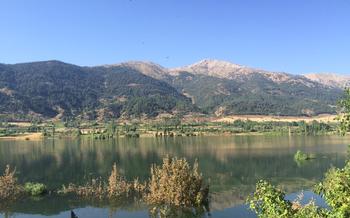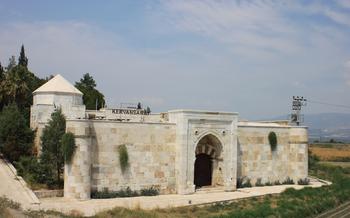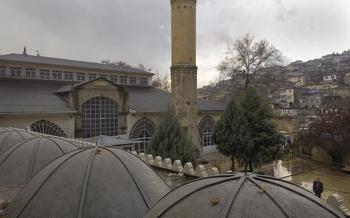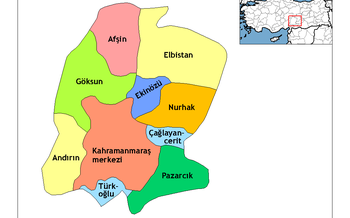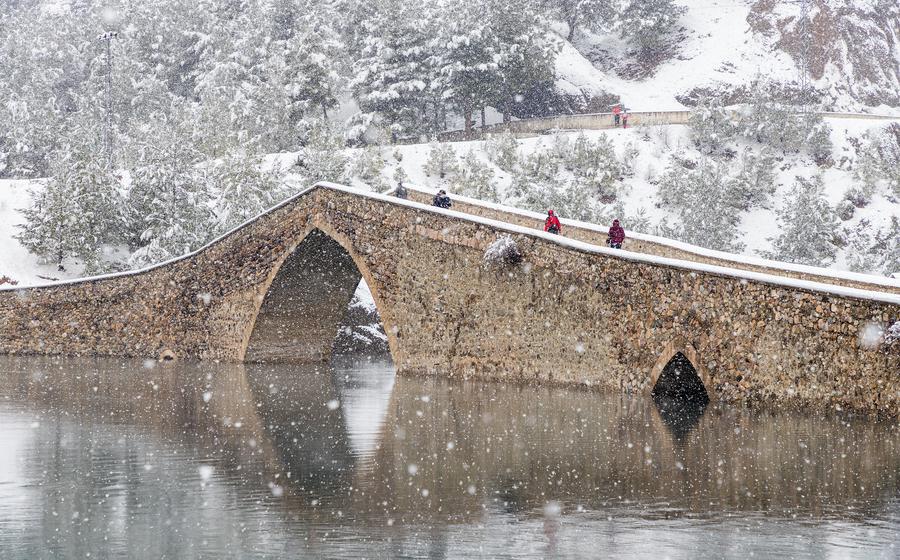
Stone Bridge (Tas Kopru)
- History of the Stone Bridge (Tas Kopru)
- Architectural Features:
- Historical Significance
- UNESCO World Heritage Site
- Surrounding Landscape
- Local Culture and Traditions
- Tourist Facilities and Amenities
- Best Time to Visit
- Photography Tips
- Nearby Attractions
- Conservation and Sustainability
- Personal Anecdotes: A Bridge to Memories
- Insider Tip
History of the Stone Bridge (Tas Kopru)
The Stone Bridge, proudly standing over the Ceyhan River in Kahramanmaraş, is a remarkable testament to the city's rich history and architectural prowess. Built in the 2nd century AD during the Roman Empire, the bridge served as a vital link between the east and west, facilitating trade and cultural exchange along the ancient Silk Road. Its strategic location on the river allowed for easy transportation of goods and people, contributing to the economic prosperity of the region.
The bridge's design is a marvel of ancient engineering, showcasing the Romans' mastery in construction techniques. Constructed using large blocks of stone, without the use of mortar, the bridge exhibits exceptional resilience and longevity. Its impressive span of 34 meters and width of 6 meters allowed for the passage of both foot and cart traffic, catering to the diverse needs of travelers.
In ancient times, the Stone Bridge was not merely a passageway but also a gathering place for locals and traders. It served as a bustling marketplace where goods were exchanged, stories were shared, and connections were forged. The bridge witnessed countless interactions, cultural fusions, and historical events, becoming an integral part of the city's fabric.
Legends and folklore have intertwined with the history of the Stone Bridge, adding an aura of mystery and enchantment to its existence. One tale speaks of a giant who built the bridge using a single stone, demonstrating his extraordinary strength. Another legend tells of a beautiful princess who crossed the bridge every day, attracting suitors from far and wide. These stories have been passed down through generations, adding to the bridge's allure and perpetuating its significance in the local culture.
Architectural Features:
The Stone Bridge, a testament to ancient engineering prowess, stands as a remarkable example of Roman architectural ingenuity. Constructed using locally quarried stones, the bridge boasts a sturdy and resilient structure that has withstood the test of time. Its impressive size and scale are evident in its dimensions, spanning a length of approximately 120 meters (394 feet) and reaching a height of 15 meters (49 feet).
The bridge's design incorporates a series of semi-circular arches, a hallmark of Roman bridge construction. These arches, supported by sturdy piers, distribute the weight of the bridge evenly and provide stability against the force of the river's current. The piers, in turn, feature triangular cutwaters on their upstream faces, which serve to deflect the force of the water and protect the bridge from erosion.
The bridge's surface is paved with large, flat stones, creating a smooth and even path for travelers. The stones have been worn smooth over centuries of use, adding to the bridge's charm and historical character. Along the sides of the bridge, stone parapets provide safety barriers, ensuring the safety of those crossing.
One of the most distinctive features of the Stone Bridge is its intricate carvings and sculptures. These decorative elements, meticulously crafted by skilled artisans, adorn the bridge's piers and parapets, adding a touch of elegance and artistry to the structure. The carvings depict various motifs, including floral patterns, human figures, and mythical creatures, showcasing the rich artistic traditions of the Roman Empire.
Compared to other similar bridges in the region, the Stone Bridge stands out for its exceptional preservation. While many ancient bridges have succumbed to the ravages of time and neglect, the Stone Bridge has been meticulously maintained and restored, ensuring its continued existence for generations to come. Its enduring legacy serves as a reminder of the remarkable engineering achievements of the Roman Empire and continues to inspire awe and admiration among visitors from around the world.
Historical Significance
The Stone Bridge (Tas Kopru) in Kahramanmaraş, Turkey, holds immense historical significance, serving as a crucial link in ancient trade routes and facilitating cultural exchanges between diverse civilizations. Its strategic location allowed merchants, travelers, and pilgrims to traverse the Ceyhan River, connecting the Anatolian hinterland with the Mediterranean coast.
Throughout history, the bridge played a pivotal role in the development of the region, contributing to its economic prosperity and cultural vibrancy. It served as a vital artery for trade, enabling the exchange of goods and ideas between the East and the West. The bridge facilitated the movement of caravans carrying precious commodities such as spices, silks, and textiles, contributing to the flourishing of trade networks that spanned vast distances.
The Stone Bridge also witnessed significant historical events and battles, further solidifying its strategic importance. In the 12th century, the bridge was a focal point during the Crusades, as armies clashed for control of the region. Its sturdy structure withstood the ravages of war, serving as a testament to its resilience and enduring significance.
In recognition of its exceptional historical value, the Stone Bridge has undergone meticulous restoration efforts to preserve its integrity and maintain its grandeur for future generations. These efforts have ensured that this iconic landmark continues to stand as a symbol of resilience, connectivity, and the rich cultural heritage of Kahramanmaraş.
UNESCO World Heritage Site
The Stone Bridge's exceptional cultural and historical significance has earned it the prestigious designation of a UNESCO World Heritage Site. This recognition acknowledges the bridge's outstanding universal value as a testament to human ingenuity and engineering prowess. The bridge's unique design and construction techniques, coupled with its enduring role in trade and cultural exchange, make it an invaluable asset to the world's cultural heritage.
UNESCO's recognition not only celebrates the bridge's past but also ensures its preservation for future generations. By becoming part of the World Heritage List, the bridge receives international protection and support for conservation efforts. This designation also raises awareness of the bridge's importance and encourages responsible tourism practices to minimize the impact on its delicate structure and surroundings.
Preserving and protecting the Stone Bridge is crucial for maintaining the integrity of this ancient marvel. UNESCO's designation as a World Heritage Site plays a vital role in safeguarding this cultural treasure for the enjoyment and appreciation of people worldwide.
Surrounding Landscape
The Stone Bridge (Taş Köprü) is situated amidst a breathtaking natural landscape that enhances its allure. The bridge spans the crystal-clear waters of the Kahramanmaraş River, which meanders through a picturesque valley surrounded by majestic mountains. The surrounding terrain is a tapestry of lush greenery, with towering trees and vibrant wildflowers painting a vibrant canvas.
The area around the bridge is a haven for nature enthusiasts and outdoor adventurers. Visitors can embark on invigorating hikes along scenic trails that wind through the verdant hills and offer panoramic views of the bridge and the surrounding countryside. For those seeking a more leisurely experience, nature walks or picnics in the tranquil surroundings provide an opportunity to soak in the beauty of the landscape and connect with nature.
The bridge's location also presents remarkable opportunities for photography. The interplay of light and shadow on the bridge's arches, the reflections dancing on the river's surface, and the backdrop of the rugged mountains create a photographer's paradise. Whether capturing the bridge's grandeur against the backdrop of a golden sunset or experimenting with long exposure shots to blur the flowing water, the possibilities for capturing stunning images are endless.
Local Culture and Traditions
The Stone Bridge is deeply embedded in the local culture and traditions of Kahramanmaraş. It is considered a symbol of the city's rich history and heritage, and its significance extends beyond its architectural and engineering marvels.
One of the most notable cultural aspects associated with the bridge is the annual "Bridge Festival," held every summer to celebrate the bridge's enduring legacy. The festival showcases traditional Turkish music, dance performances, and local handicrafts, attracting visitors from near and far.
The bridge also holds a special place in local folklore. Legends and tales abound about mythical creatures that inhabit the waters beneath the bridge, and it is said that crossing the bridge at midnight can bring good luck or fulfill wishes. These stories have been passed down through generations and reflect the deep connection between the bridge and the local community.
For visitors interested in experiencing the local culture, there are opportunities to interact with artisans who create traditional crafts and souvenirs inspired by the bridge. Visitors can also savor the flavors of regional cuisine at nearby restaurants, which offer dishes that have been influenced by the bridge's history and surroundings.
Overall, exploring the Stone Bridge is not just about admiring its architectural beauty but also about immersing oneself in the vibrant local culture and traditions that surround it.
Tourist Facilities and Amenities
The Stone Bridge offers a range of facilities and amenities to enhance the visitor experience. To fully appreciate the bridge's grandeur, guided tours are available, providing in-depth insights into its history, architecture, and cultural significance. These guided tours are led by knowledgeable local experts who bring the bridge's stories to life, making the visit even more immersive.
Accessibility is a priority at the Stone Bridge. Visitors with disabilities or special needs can take advantage of ramps, elevators, and accessible restrooms, ensuring everyone can enjoy the bridge's wonders. Whether you prefer to explore independently or with a group, the visitor center provides valuable information, maps, and brochures to guide your journey.
After a captivating exploration of the bridge, visitors can relax and refuel at nearby restaurants and cafes. These eateries offer a variety of local and international cuisines, allowing you to savor delicious meals while enjoying the bridge's stunning backdrop. For those who prefer a more intimate experience, designated picnic areas are available, where you can spread out a blanket, unpack your favorite snacks, and bask in the tranquility of the surroundings.
The Stone Bridge also offers a range of souvenirs and mementos for visitors to cherish their visit. From postcards and stamps depicting the bridge's iconic silhouette to intricately crafted replicas and local handicrafts, there's something for every taste and budget. Whether you're looking for a unique gift for a loved one or a special reminder of your journey, these souvenirs will transport you back to the magic of the Stone Bridge.
Best Time to Visit
-
Recommended time of year or season for visiting the bridge based on weather conditions: Consider visiting the Stone Bridge during the spring (April-May) or autumn (September-October) when the weather is mild and pleasant. During these seasons, you can enjoy the surrounding natural beauty without extreme heat or cold, making it ideal for outdoor activities like hiking and picnics. The shoulder months offer a quieter experience with fewer tourists, allowing you to savor the bridge's tranquility.
-
Special events or festivals that take place near the bridge during certain times of the year: Check the local calendar for special events or festivals that may coincide with your visit. The annual Kahramanmaraş Sütçü İmam Festival, held in June, celebrates the city's culinary heritage with dégustations of the famous Maraş ice cream. The event takes place near the Stone Bridge, offering a chance to immerse yourself in local traditions and flavors.
-
Tips for avoiding crowds or finding the best time to experience the bridge's tranquility: To avoid large crowds, plan your visit for early mornings or late afternoons on weekdays. If possible, steer clear of weekends and public holidays, when the bridge attracts more visitors. Alternatively, seek out secluded spots along the riverbank or nearby trails to find moments of solitude and appreciate the bridge's majesty from a different perspective.
-
Considerations for photography enthusiasts seeking optimal lighting conditions: For photography enthusiasts, the golden hours of sunrise and sunset offer the most dramatic lighting conditions to capture the bridge's beauty. The warm hues of the sky beautifully illuminate the stonework and create stunning reflections on the water's surface. Experiment with different angles and compositions to capture unique shots that showcase the bridge's grandeur.
Photography Tips
The Stone Bridge (Taş Köprü) presents endless opportunities for photography enthusiasts to capture its grandeur and historical essence. To make the most of your photographic journey, consider these tips:
-
Explore Different Angles: Walk around the bridge to discover unique perspectives. The bridge's arches, intricate carvings, and reflection in the water offer a variety of compositions.
-
Harness Natural Light: Visit during the golden hours of sunrise and sunset to capture the bridge bathed in warm, diffused light that enhances its textures and colors.
-
Experiment with Reflections: Position yourself so that the bridge's reflection dances on the water's surface, creating a mesmerizing effect. Use a slow shutter speed to blur the water for a silky, painterly look.
-
Capture the Details: Don't forget to zoom in and capture the intricate details of the bridge's carvings, weathered stones, and worn surfaces. These close-ups will add depth and character to your photographs.
-
Post-Processing Magic: Use photo editing software to fine-tune your images. Adjust the contrast, colors, and sharpness to make your photos pop. Experiment with black-and-white conversions for a timeless, classic look.
Nearby Attractions
The Stone Bridge (Taş Köprü) stands as a testament to the rich history and cultural heritage of Kahramanmaraş, Turkey. While the bridge itself is a must-see destination, visitors can enhance their experience by exploring the array of nearby attractions that complement the bridge's significance.
A short walk from the bridge leads to the Kahramanmaraş Museum, which houses a collection of artifacts and exhibits that delve into the region's past. From ancient pottery and tools to traditional costumes and textiles, the museum provides a deeper understanding of the cultural tapestry that has shaped Kahramanmaraş.
Nature enthusiasts will find solace in the Sütçü İmam Waterfall, located just a few kilometers from the bridge. This cascading waterfall offers a refreshing respite from the city's hustle and bustle, inviting visitors to bask in the tranquility of nature's beauty.
For those seeking a spiritual connection, the Grand Mosque of Kahramanmaraş stands as a majestic symbol of Islamic architecture. This awe-inspiring mosque, adorned with intricate tilework and soaring minarets, welcomes visitors to explore its sacred spaces and immerse themselves in the region's religious traditions.
History buffs can delve into the ancient past at the Kahramanmaraş Castle, a formidable fortress that once guarded the city from invaders. Perched atop a hill overlooking the city, the castle offers panoramic views and a glimpse into the strategic importance of Kahramanmaraş throughout the ages.
These attractions, coupled with the allure of the Stone Bridge, create an itinerary that caters to diverse interests and ensures a comprehensive exploration of Kahramanmaraş's cultural and natural treasures. Whether seeking historical insights, natural wonders, or spiritual fulfillment, visitors will find an abundance of experiences to enrich their journey in this vibrant city.
Conservation and Sustainability
The Stone Bridge has stood the test of time for centuries, but its preservation requires ongoing efforts to maintain its structural integrity and minimize the environmental impact of tourism. The local authorities, in collaboration with heritage organizations, have implemented several initiatives to ensure the bridge's longevity.
Regular inspections and maintenance work are carried out to address any deterioration or damage caused by natural elements or human activities. These measures include cleaning and repairing the bridge's surface, strengthening its foundations, and monitoring its overall stability.
To minimize the environmental impact of tourism, sustainable practices are encouraged. Visitors are advised to dispose of waste responsibly, respect the natural surroundings, and avoid activities that could harm the bridge or its ecosystem. The use of electric or hybrid vehicles is also promoted to reduce air pollution.
Local communities play a vital role in safeguarding the bridge. They are actively involved in conservation efforts, such as volunteering for clean-up activities, educating tourists about responsible behavior, and promoting the bridge's cultural significance to future generations.
By adopting sustainable practices and working together, visitors and locals can ensure that the Stone Bridge continues to stand as a testament to history, engineering, and cultural heritage for many years to come.
Personal Anecdotes: A Bridge to Memories
My first encounter with the Stone Bridge was during a spontaneous road trip through Turkey. As I approached the majestic structure, a sense of awe washed over me. The bridge seemed to emanate an aura of ancient wisdom and resilience. I spent hours marveling at its intricate details and imagining the countless stories it could tell.
One particularly memorable moment occurred as I sat on the bridge's edge, sketching its graceful arches. A local elder approached me, his eyes twinkling with curiosity. We struck up a conversation, and he shared fascinating tales of the bridge's history. He spoke of ancient travelers who crossed it, of battles fought nearby, and of the enduring legacy of the bridge as a symbol of unity and perseverance.
As I listened to his stories, I felt a deep connection to this historical marvel. The Stone Bridge became more than just a structure; it became a symbol of the rich cultural heritage and resilience of the Turkish people. It reminded me that even in the face of time's passage, some things remain steadfast and true.
I encourage you to create your own travel memories at the Stone Bridge. Whether you're an artist seeking inspiration, a history buff yearning to connect with the past, or simply a traveler in search of breathtaking beauty, the Stone Bridge has something to offer everyone. Let its grandeur inspire you, its history captivate you, and its beauty leave an everlasting impression on your soul.
Insider Tip
Explore the nearby villages: Venture beyond the bridge and explore the charming villages nestled in the surrounding countryside. Immerse yourself in the local culture, interact with friendly villagers, and discover hidden gems like traditional restaurants, artisanal workshops, and scenic hiking trails.
Capture the bridge's reflection: For a unique photographic perspective, visit the bridge during sunrise or sunset when the sky is ablaze with color. Position yourself on the opposite bank of the river to capture the bridge's reflection dancing on the water's surface.
Find a secluded spot: To escape the crowds and fully appreciate the bridge's tranquility, venture off the beaten path and find a secluded spot along the riverbank. Enjoy a peaceful picnic, soak in the natural beauty, and let the gentle sound of the flowing water transport you to a state of serenity.
Combine with a hot air balloon ride: For an unforgettable experience, combine your visit to the bridge with a hot air balloon ride over the region. Marvel at the stunning aerial views of the bridge, the meandering river, and the patchwork of fields and villages below.
Visit during a local festival: If you're fortunate enough to visit during a local festival, immerse yourself in the vibrant celebrations that often take place near the bridge. Experience traditional music, dance, and culinary delights while learning about the region's rich cultural heritage.
